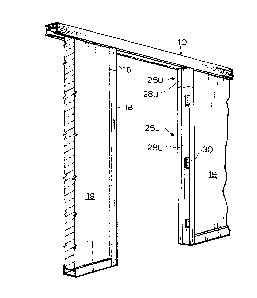Some of the information on this Web page has been provided by external sources. The Government of Canada is not responsible for the accuracy, reliability or currency of the information supplied by external sources. Users wishing to rely upon this information should consult directly with the source of the information. Content provided by external sources is not subject to official languages, privacy and accessibility requirements.
Any discrepancies in the text and image of the Claims and Abstract are due to differing posting times. Text of the Claims and Abstract are posted:
| (12) Patent: | (11) CA 1316762 |
|---|---|
| (21) Application Number: | 1316762 |
| (54) English Title: | ADJUSTABLE DOOR JAMB AND CEILING CHANNEL |
| (54) French Title: | MONTANT DE PORTE ET PROFILES DE PLAFOND REGLABLES |
| Status: | Expired and beyond the Period of Reversal |
| (51) International Patent Classification (IPC): |
|
|---|---|
| (72) Inventors : |
|
| (73) Owners : |
|
| (71) Applicants : |
|
| (74) Agent: | |
| (74) Associate agent: | |
| (45) Issued: | 1993-04-27 |
| (22) Filed Date: | 1988-12-08 |
| Availability of licence: | Yes |
| Dedicated to the Public: | N/A |
| (25) Language of filing: | English |
| Patent Cooperation Treaty (PCT): | No |
|---|
| (30) Application Priority Data: | ||||||
|---|---|---|---|---|---|---|
|
A B S T R A C T
A door jamb assembly for a movable wall system
provides a downwardly open top channel, a pair of telescoping
members attached to the door channels defining the sides of
the opening and the telescoping members define a shape open
away from the door opening to receive the edge of a wall panel.
The top channel has a pair of L shaped members therein defining
with the top wall of the channel on inner channel which receives
coiled springs to bias a concealing plate or panel downwardly for
a finished door transom and pleasant appearance. A slotted base
plate receives the door channel, which can be placed or lifted
away without fastening by its telescoping nature.
Note: Claims are shown in the official language in which they were submitted.
Note: Descriptions are shown in the official language in which they were submitted.

2024-08-01:As part of the Next Generation Patents (NGP) transition, the Canadian Patents Database (CPD) now contains a more detailed Event History, which replicates the Event Log of our new back-office solution.
Please note that "Inactive:" events refers to events no longer in use in our new back-office solution.
For a clearer understanding of the status of the application/patent presented on this page, the site Disclaimer , as well as the definitions for Patent , Event History , Maintenance Fee and Payment History should be consulted.
| Description | Date |
|---|---|
| Inactive: IPC from MCD | 2006-03-11 |
| Inactive: IPC from MCD | 2006-03-11 |
| Time Limit for Reversal Expired | 2005-04-27 |
| Inactive: Adhoc Request Documented | 2004-07-07 |
| Letter Sent | 2004-04-27 |
| Inactive: CPC assigned | 2003-04-25 |
| Inactive: Adhoc Request Documented | 1998-04-27 |
| Inactive: Office letter | 1998-03-11 |
| Letter Sent | 1997-04-28 |
| Grant by Issuance | 1993-04-27 |
There is no abandonment history.
| Fee Type | Anniversary Year | Due Date | Paid Date |
|---|---|---|---|
| MF (category 1, 5th anniv.) - small | 1998-04-27 | 1998-02-27 | |
| MF (category 1, 6th anniv.) - small | 1999-04-27 | 1999-04-22 | |
| MF (category 1, 7th anniv.) - small | 2000-04-27 | 2000-03-13 | |
| MF (category 1, 8th anniv.) - small | 2001-04-27 | 2001-02-12 | |
| MF (category 1, 9th anniv.) - small | 2002-04-29 | 2002-04-03 | |
| MF (category 1, 10th anniv.) - small | 2003-04-28 | 2003-02-13 |
Note: Records showing the ownership history in alphabetical order.
| Current Owners on Record |
|---|
| OTTO GASTEIGER |
| Past Owners on Record |
|---|
| None |